M44 armored personnel carrier (USA)
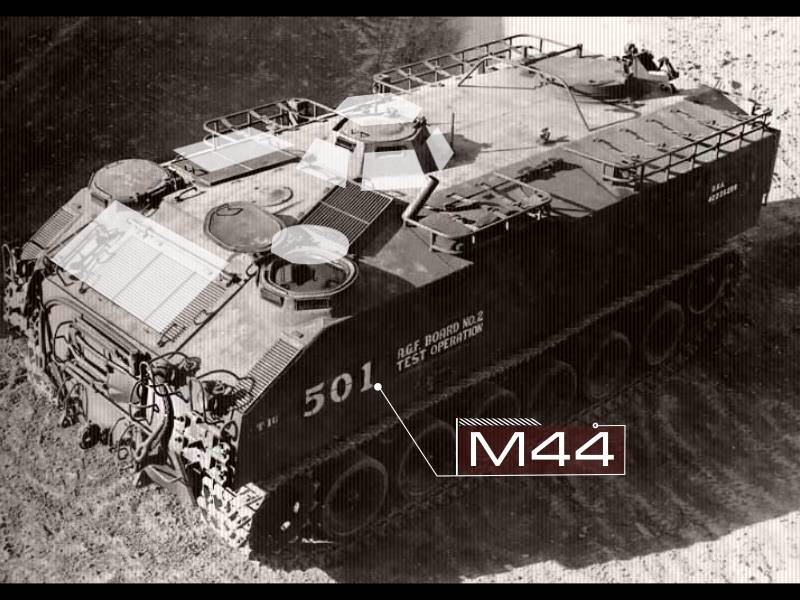
Long before the end of World War II, the American command realized that the existing semi-tracked armored personnel carriers did not meet modern requirements and therefore needed to be replaced. A new technique of similar purpose was supposed to be built using other ideas and solutions, as well as on the basis of completely different concepts. As part of the first attempt to create such a vehicle, an M44 armored personnel carrier was built, built in a relatively small series and limitedly used by troops.
Existing armored personnel carriers had a number of serious flaws. The bulk of this technique was a rather old machine with a half-track undercarriage. Such armored personnel carriers did not have a high level of protection, and also had limitations on mobility and capacity. As a result, by the autumn of 1944, the need to create a new technology of this class has ceased to be a subject of controversy, the issue of launching new projects has been resolved. On November 9, the Defense Ministry issued an order to begin developing a project with the symbol T13. In the future, such a machine, which differs from the existing ones by most features, could become the main means of transporting personnel.
The T13 armored personnel carrier was supposed to take on board from 18 to 22 soldiers with weapons, not counting the crew, and have a combat weight of 17,7 tons. It was proposed to equip the car with a power plant borrowed from the lung tank M24 Chaffee. Thus, she was supposed to receive two Cadillac V-8 engines and a transmission of the Hydramatic type. The maximum speed of the armored car on the highway was to reach 55 km / h, range - 400 km. The car was supposed to be driven by a crew of two people. Protection was assigned to armor up to 12,7 mm thick. Armament - one heavy machine gun on a turret. On the basis of such a machine should also be made tracked unarmored vehicles. This technique has been designated T33.
Over the next few months, specialists from the army and industry jointly worked through various aspects of promising projects. By the beginning of spring 1945, conclusions were made that determined the future development of the project. Calculations showed that the proposal to use the power plant of a light tank M24 does not allow to obtain the desired mobility. March 22 received instructions to terminate work on the project T13 / T33. This order also indicated the need to continue the development of armored personnel carriers, but now in such projects the power units from self-propelled artillery M18 Hellcat should be used.
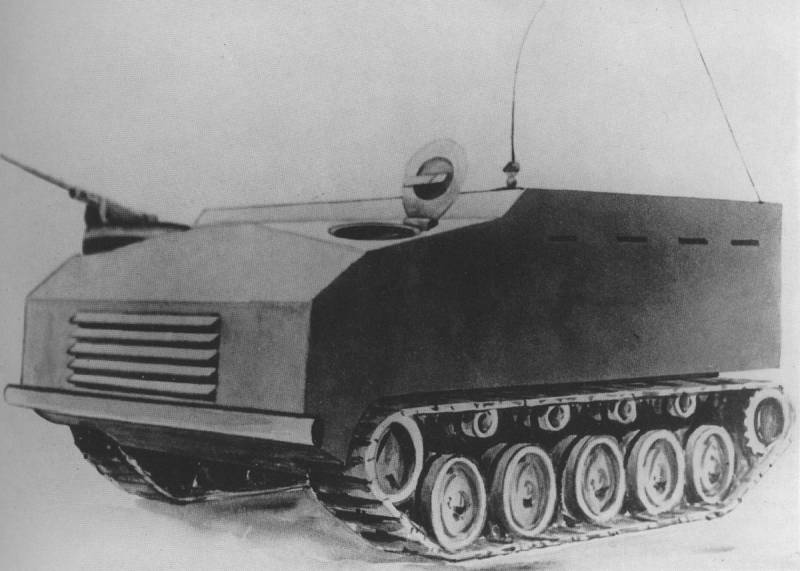
Machine E13 in the view of the artist. Picture Hunnicutt, RP "Bradley: A History of American Fighting and Support Vehicles"
5 April 1945 was officially launched the new project. In view of the updated requirements, a new version of the armored personnel carrier called T16 should have been created. The development of the project was entrusted to Cadillac Motor Car Division of General Motors Corp. In the near future, she should have presented a finished project for a promising vehicle for transporting soldiers, and then building a number of prototypes. In addition to the original task of transporting soldiers with weapons in the new project, it was necessary to take into account the possibility of using the machine in new qualities. So, until a certain time it was supposed to make the T16 the basis for a promising self-propelled mortar.
Using the main developments on the already finished, but canceled project, the contractor company in the shortest possible time created a new machine. At the same time, in the T16 project, some ideas were used to improve the basic characteristics. In particular, it was possible to increase the capacity of the troop compartment and improve some other parameters. Despite a slight increase in size and weight, the mobility of the armored personnel carrier had to meet the requirements due to the power plant used.
Already 12 April, the military department approved the assembly of experimental equipment. The first batch of six cars should be put to the test in June. In the future, the construction of new prototypes was not ruled out, followed by the full-fledged mass production in the interests of rearmament of the army.
Technical requirements for the original project T13 stipulated the need to transport 18-22 soldiers with weapons. As part of the T16 project, the possibility was found of increasing the number of paratroopers to 24. Such results were achieved with the help of the correct layout of the case and optimization of the use of its internal spaces. It is noteworthy that similar ideas of the new project, affecting the placement of the internal units of the body, later found application in the course of creating a number of other machines of similar purpose. It can even be argued that the T16 BTR was the first modern-style vehicle of this kind created in the USA.
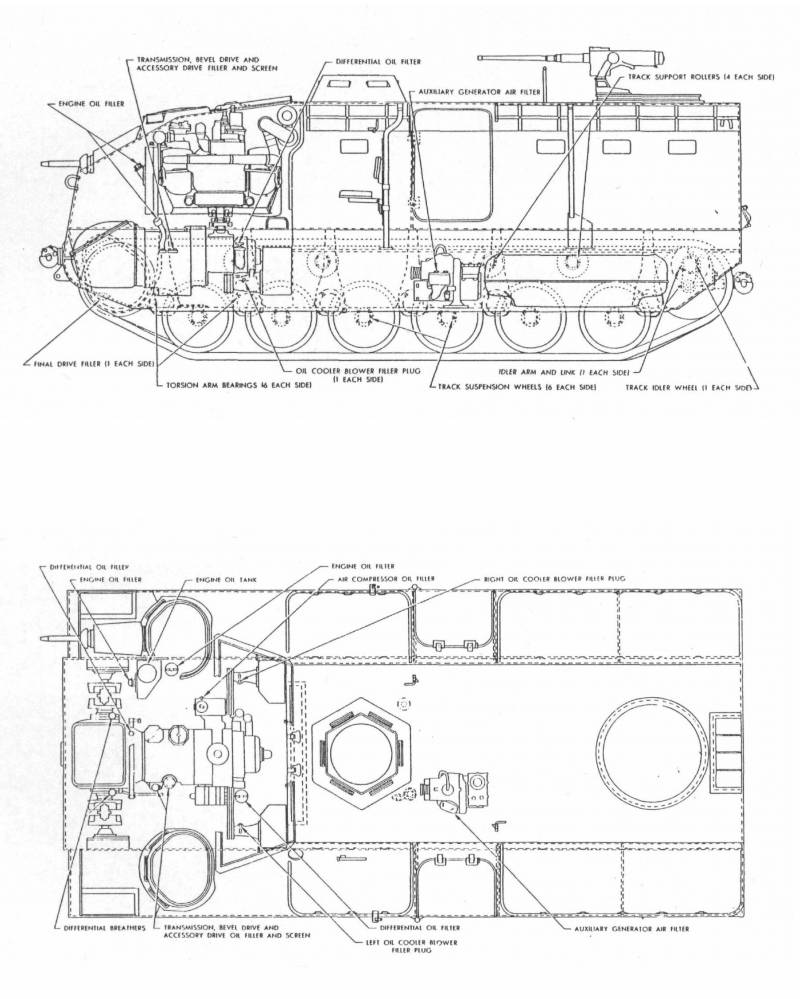
Scheme of an armored personnel carrier. Picture Hunnicutt, RP "Bradley: A History of American Fighting and Support Vehicles"
Prospective armored personnel carrier received a welded body of armored steel, which has a characteristic shape. The frontal projection was protected by several sheets with a thickness from 9,5 to 16 mm, placed at different angles to the vertical. There were also vertical sides with a thickness of 12,7 mm. The maximum thickness of the feed parts was 12,7 mm. The hull had a sloping upper frontal part mating with the roof. The latter differed in a reduced width and was connected to the vertical sides with the help of side inclined sheets. The main means of increasing the internal volume of the machine were developed fiddling niches that run along the entire length of the hull.
The layout of the body of the BTR T16 was determined in accordance with the intended role on the battlefield, as well as taking into account the maximum safety of the crew and the landing force. The front of the case was supposed to contain a large engine compartment, next to which the control compartment was located. All other hull volumes were given under the troop compartment of increased size. Under the upper habitable volume provided for a smaller lower, located at the level of the chassis. There were fuel tanks, batteries, a generator, etc.
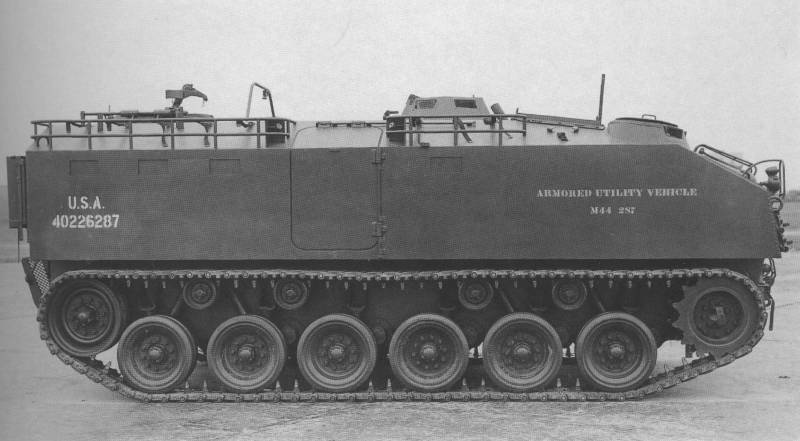
View of the starboard. Photo Hunnicutt, RP "Bradley: A History of American Fighting and Support Vehicles"
The T16 project was supposed to use M18 self-propelled power units. For installation in the new case, the existing systems had to be noticeably modified. In particular, this was due to the placement of all devices in a single compartment. In front of the hull fit a radial nine-cylinder gasoline engine Continental R-975-D4 power hp 400. It was connected to the 900AD Torqmatic transmission, which provided three forward speeds and one reverse. As in the case of a serial self-propelled gun, the transmission provided the output of torque to the drive wheels of the front layout. However, now the engine and transmission are not connected with the help of a propeller shaft, passing under the habitable compartment.
The chassis of the armored personnel carrier was based on the units of serial equipment. On each side of the hull there were six dual track rollers. The rollers had an independent torsion bar suspension. In addition, four skating rinks on each side (with the exception of two medium ones) received additional shock absorbers. The drive wheels of the pinching gear were placed in the front of the hull, and in the stern were the mechanisms for tensioning the tracks with guide wheels. Each board also housed four supporting rollers.
In front of the hull of the armored vehicle T16 located crew jobs. In connection with the placement of the engine in the center of the case, the driver and the shooter had to be on opposite sides of the motor housing. At the left side was a driver, having at its disposal a full control post. Near the starboard, in turn, was placed the shooter. He could use a machine gun in a course set. The driver and the shooter should have fallen into place with the help of their own hatches in the roof. Next to the hatches there were three rather large viewing devices. The commander was placed in a separate place in front of the troop compartment. A hexagonal turret with optical devices on all faces was installed above its place. The turret roof was made folding and served as the hatch.
Most of the internal volume of the hull was given under the troop compartment. It was proposed to install the seats of long benches on the bottom sheet of the fencing niches. For more convenience, these shops had a narrow long back, mounted on board the hull. Two more shops for the landing were located in the center of the department. Thus, the armored personnel carrier could carry the 24 paratrooper, arranged in four rows. The T16 project provided advanced means for landing and leaving. In the stern sheet of the hull were two doors located at the aisles between the benches. For more convenience, there were foldable steps under the stern hatches. Two more hatches were located in the central part of the fencing niches. The hatches were covered with two covers: the top was tilted up, to the center of the car, the bottom - forward in the direction of travel. On the bottom hatch cover there was a design that held part of the back of the bench. Thus, the presence of side hatches did not affect the comfort of the paratroopers during the movement.
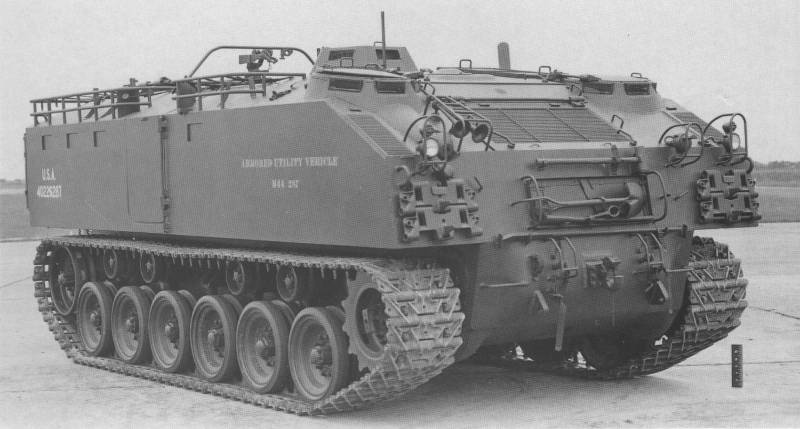
The fencing niches passed along the entire length of the hull. Photo Hunnicutt, RP "Bradley: A History of American Fighting and Support Vehicles"
A promising armored personnel carrier received machine-gun armament necessary for self-defense and fire support of the dismounted movement. In the front hull sheet, on the starboard side, there was a ball mount with a machine gun of a rifle caliber M1919A4. Ammunition machine gun consisted of 1000 cartridges. Gun control was carried out manually. Course machine gun supplemented anti-aircraft M2HB caliber 12,7 mm. Heavy machine gun mounted on the turret type T107. It was placed aft of the roof above its own hatch. If necessary, the hatch cover reclined to the right, allowing the arrow to rise and control the machine gun.
Marines had the opportunity to fire from personal weapons. For this purpose, a set of embrasures was provided in the sides of the troop compartment. One such device, equipped with a sliding cover, was located in front of the side hatches, three each behind them. Two more embrasures were mounted in the stern sheet at the sides, on the sides of the doors. Actually the door did not receive such equipment.
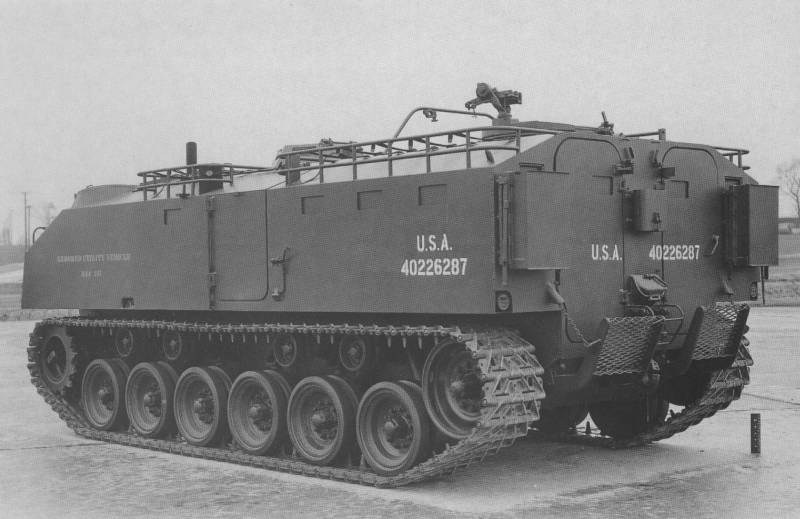
Port side and feed. Photo Hunnicutt, RP "Bradley: A History of American Fighting and Support Vehicles"
The new T16 project differed from the previous T13 in a number of characteristic features, first of all, in the increased size of the troop compartment. This led to a marked increase in the size and weight of the vehicle. The length of the armored personnel carrier 6,51 m, width - 2,44 m, height on the roof - 2,54 m. Height, taking into account the commander's cupola - 3,03 m. Combat weight reached 23 t against 17,7 t, set by the initial technical requirements of the customer.
The 400-strong engine was supposed to provide power density at the 17,4 HP level. per ton, which allowed to count on high mobility. The maximum speed on the highway was to reach 51 km / h, the power reserve was determined at the level of 290 km. The machine could climb the slope of a steep 30 ° or a wall height of 61 cm. The trench width 2,1 m was provided. The turning radius was at least 13 m.
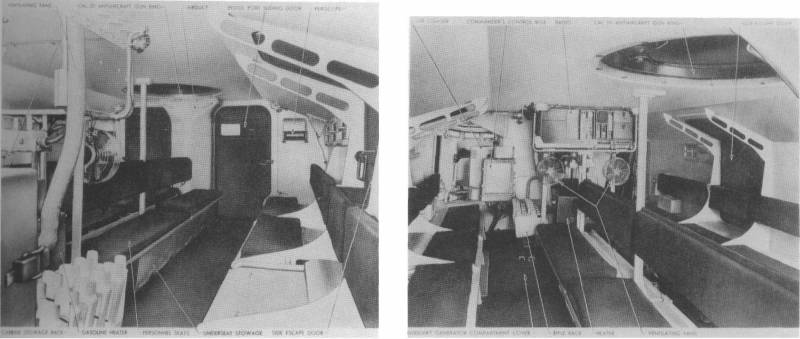
Inhabited compartment. On the left - a view of the stern, on the right - forward. Photo Hunnicutt, RP "Bradley: A History of American Fighting and Support Vehicles"
In April 1945, the US military ordered the construction of an experimental batch of six armored vehicles with the supply of equipment until June inclusive. Cadillac easily coped with this task and in time presented all the required armored personnel carriers. Soon the equipment entered the landfill and confirmed the calculated characteristics. The T16 BTR, even in the very first version, could actually carry a whole platoon of soldiers on a highway or rough terrain, protect it from small arms and support it with machine-gun fire. In this case, the arrows could attack two targets simultaneously, which could give certain advantages in a combat situation.
Tests of new technology continued until the end of the Second World War. After the capitulation of Japan, the tests were continued. Around this time, an experienced BX T16 received a new designation of Armored Utility Vehicle M44. Interestingly, the promising armored personnel carrier was designated as "General Armored Vehicle" or "Auxiliary Armored Vehicle". Tests of six prototypes continued at the testing grounds of the Aberdeen and Fort Knox bases. In the course of these works, the capabilities of the new equipment were tested, and the methods for its combat use in certain conditions were determined. Taking into account the experience of these events, the military planned to develop strategies for the operation of new equipment on the battlefield.
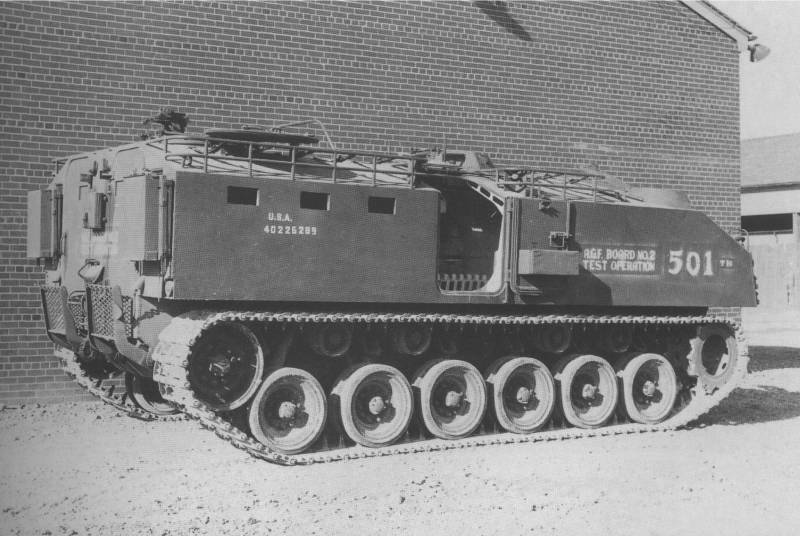
Armored personnel carrier with open side hatches. Photo Hunnicutt, RP "Bradley: A History of American Fighting and Support Vehicles"
Experienced armored personnel carriers T16 / M44 performed well, but it was considered impossible to adopt such equipment. For certain reasons, one of the main advantages of the machine has become a fatal flaw. By the fall of 1945, the US command updated the requirements for armored vehicles for the transport of soldiers. An armored personnel carrier capable of transporting the whole platoon did not meet the updated requirements: now the military wanted to operate the vehicles that take on board only one branch. Nevertheless, the car was put into trial operation, although it was not accepted for service as a full-fledged model. Technique with the status of Limited standart used only at the sites and were not going to put in the series. The transfer of machines to combatant units was also excluded.
Tests of six combat vehicles continued until the autumn of 1946, when a proposal was made to carry out modernization, taking into account the accumulated experience. October 31 issued an order to finalize an existing project in order to correct the identified deficiencies and enhance some characteristics. This version of the "general purpose armored vehicle" was named M44E1. The purpose of the new project was to improve the existing technology for some research and testing. Adoption of the armored vehicle was still not planned.

One of the six prototypes during the test. Photo Military-vehicle-photos.com
In the front engine compartment, it was now proposed to mount a Continental AOS-895-1 engine with an 500 horsepower. The existing transmission was replaced with a CD-500 system. The chassis has received a new caterpillar of increased width. A renewed hatch appeared in the roof, which, as it was supposed, made it possible to abandon the side doors. A large-caliber anti-aircraft gun was also removed from the roof. The customer considered that such changes to a certain extent would increase the ease of operation and the main characteristics of the machine.
At least one prototype base machine was re-equipped according to the M44E1 project and subsequently tested. Indeed, some characteristics of the technique have improved. First of all, the mobility of technology has slightly increased. However, the rest of the updated design armored personnel carrier almost did not differ from the original machine. All the main characteristics are almost unchanged, which gave no noticeable advantages over the base M44.
Prospective tracked armored personnel carriers M44 and M44E1 had rather high characteristics and could be of interest to the army. However, during the testing of this technique, a potential customer in the face of the US Army changed its views on new armored personnel carriers. An armored vehicle capable of carrying a platoon of infantrymen was no longer interested in the military. Now they wanted to get a smaller sample that could accommodate a smaller number of fighters, namely an infantry unit. No refinements to existing projects allowed the T16 / M44 to comply with such requirements. As a result, it could not be put into service and enter mass production.
After the tests were completed, six armored vehicles were decommissioned, and soon went to dismantle. Some sources mention the use of such technology during the Korean War, but there is no evidence of this. Most likely, M44 simply did not live to see the beginning of this conflict, since they were dismantled by the beginning of the fifties.
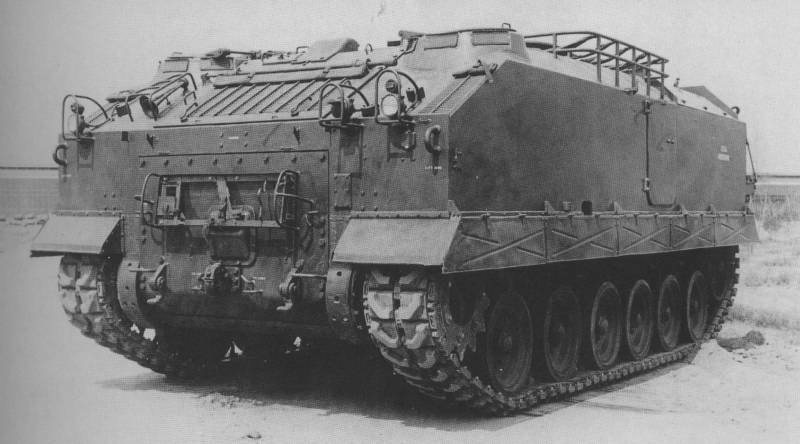
Experienced M44E1. Photo Hunnicutt, RP "Bradley: A History of American Fighting and Support Vehicles"
Further development of the US tracked armored personnel carriers was carried out using some of the developments of the M44 project, but now the equipment was created taking into account the updated requirements. All new American armored personnel carriers were smaller than their predecessor and contained a different number of soldiers. Thus, the first draft of the modern look in this area did not give real results and did not lead to the beginning of the immediate rearmament of the army, but allowed to determine the prospects of certain decisions that were later used to create new technology.
Based on:
http://afvdb.50megs.com/
http://zonwar.ru/
http://armchairgeneral.com/
Hunnicutt, RP Bradley: A History of American Fighting and Support Vehicles. Navato, CA: Presidio Press, 1999.
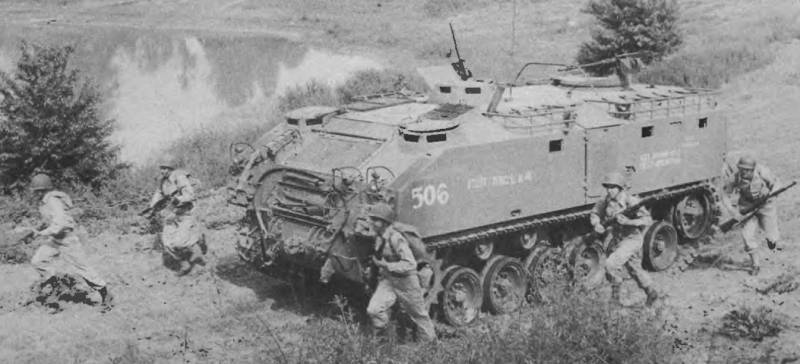
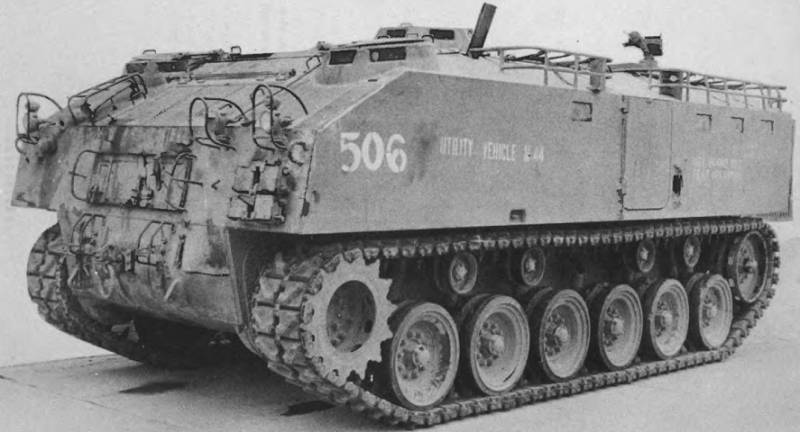
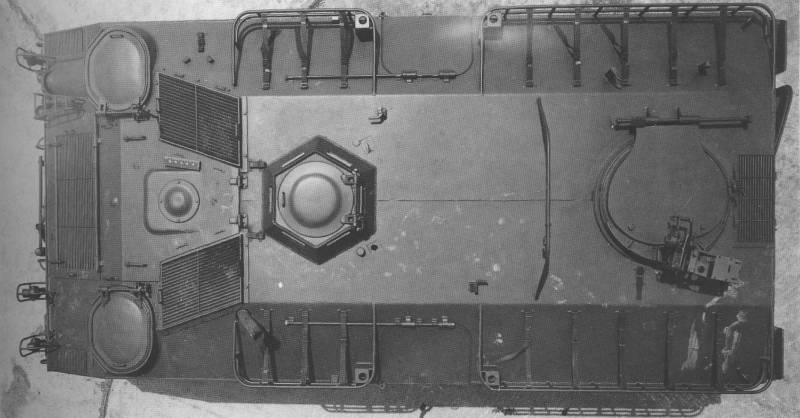
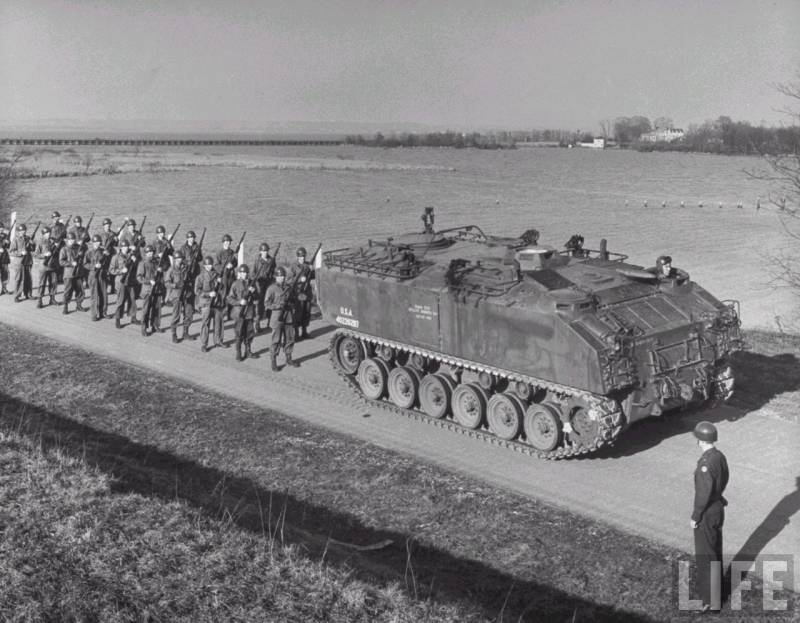
Information